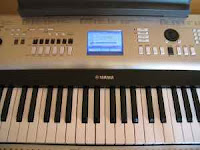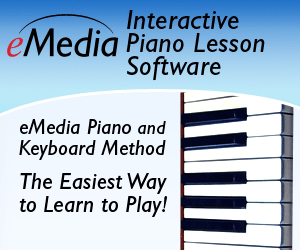 UPDATED REVIEW - September 1, 2015 - NOT RECOMMENDED for piano playing realism - If you are a piano student or recreational player wanting a good accurate and piano weighted key action in a digital piano, I do not recommend the Yamaha YPG535 ($499 internet discount price - left pic) because it does not have the weighted piano hammer type key movement. Yamaha is a great piano company and makes many different models of acoustic & digital pianos, but the YPG535 which has been out now for over 5 years (old technology), is really a glorified keyboard with 88-keys. Although the keys themselves look similar to a piano key shape, they actually have the same spring key movement and feel as a Yamaha 61 or 76-key keyboard which have the lightweight spring-type key actions and are not full or even partial piano hammer weighted. However, the YPG535 is an enjoyable instrument to play just for fun because it has lots of very nice sounds, drum rhythms, chord arrangements, recording features and other fun things that make it a cool instrument to own for both young people and adults. It even sounds somewhat (but not actually) like a piano so it would "appear" to be a good low priced digital piano for students and players. But as far as a realistic weighted piano key touch and acoustic piano resonating tone and dynamics...it's not even close to the real thing.
UPDATED REVIEW - September 1, 2015 - NOT RECOMMENDED for piano playing realism - If you are a piano student or recreational player wanting a good accurate and piano weighted key action in a digital piano, I do not recommend the Yamaha YPG535 ($499 internet discount price - left pic) because it does not have the weighted piano hammer type key movement. Yamaha is a great piano company and makes many different models of acoustic & digital pianos, but the YPG535 which has been out now for over 5 years (old technology), is really a glorified keyboard with 88-keys. Although the keys themselves look similar to a piano key shape, they actually have the same spring key movement and feel as a Yamaha 61 or 76-key keyboard which have the lightweight spring-type key actions and are not full or even partial piano hammer weighted. However, the YPG535 is an enjoyable instrument to play just for fun because it has lots of very nice sounds, drum rhythms, chord arrangements, recording features and other fun things that make it a cool instrument to own for both young people and adults. It even sounds somewhat (but not actually) like a piano so it would "appear" to be a good low priced digital piano for students and players. But as far as a realistic weighted piano key touch and acoustic piano resonating tone and dynamics...it's not even close to the real thing. Yamaha calls their YPG535 key action a graded soft touch keyboard and that would be true (especially the soft touch part that is). It's easy to press the white keys up and down (except for the black keys which are much harder to press because of the stiffer spring mechanism and pivot point), and that is not what you want if you are interested in developing good piano playing habits and skills. The keys are also quite noisy when moving up & down, especially the black keys! Not only is the key action noisy and not a good one for duplicating an acoustic piano touch, but the key polyphony memory (especially useful when playing larger passages of music or layering instrument sounds together) is a low 32-notes which is very outdated piano processing technology but also costs less money to produce. Normal polyphony memory these days is somewhere between 64 to 256 notes in lower priced digital pianos (under $1500), so this one is extremely low. Also, if you are using the regular acoustic piano tone, it starts sounding like an electric piano as you get nearer to the top octaves. In other words, the piano doesn't reproduce a realistic piano tone in the upper octaves (it's better in the lower octaves) and that's due to the less expensive sound piano sampling technology in this model.
The piano sound itself has minimal dynamic range (changes in the tone from mellow to bright like on acoustic pianos) when trying to get softer mellower tone on up to bright resonate tone when playing at different finger pressure on the keys. When you're progressing as a piano student (or if you already play) morepolyphony memory and good dynamic range tonality is needed for playing at an intermediate to higher skill level (above beginner level) of music including using the piano sustain pedal. The minimum polyphony in any digital piano should be at least 64-notes and the preferable polyphony should be at least 128 notes or more as it is in many other Yamaha digital pianos. If you are and will remain at a beginner skill level, this may not be an issue for you, but hopefully you won't be a beginner forever:). Even if you only play at beginner level, you still should have a more authentic key action.
With regard to the piano pedal, the YPG535 piano only allows the single pedal that comes with it to produce an on & off sustain instead of a graduated (half-pedal) sustaining of notes. This is not the way regular acoustic pianos work and so you should be sure if at all possible that the digital piano you purchase has a "half-pedaling" feature, especially if you hope to go beyond a beginning skill level. Most of the better Yamaha digital pianos do have this feature as well as other good brands including Casio, Kawai, and Roland.
 As I mentioned earlier, the Yamaha YPG535 is a fun piano to play, has a cool user interface display (left pic), has good speaker volume, and if you don't care at all about the key action weight and movement being like an acoustic piano or the piano sound being closer to a real piano over the the entire keyboard, then this piano could be a very good option for people who just want lots of cool electronic features, good quality instrument sounds, fun rhythms, interactive user interface, and USB flash drive input and USB output for direct connect to computers.
As I mentioned earlier, the Yamaha YPG535 is a fun piano to play, has a cool user interface display (left pic), has good speaker volume, and if you don't care at all about the key action weight and movement being like an acoustic piano or the piano sound being closer to a real piano over the the entire keyboard, then this piano could be a very good option for people who just want lots of cool electronic features, good quality instrument sounds, fun rhythms, interactive user interface, and USB flash drive input and USB output for direct connect to computers.| Casio CGP700 |
My goal here is not to list the amount of instrument sounds, rhythms, accompaniments, recording tracks, or other extra features these pianos have because they all do a good job of that. But I want to focus on proper key action movement and piano tone quality & dynamics along with pedaling which are of primary importance to me, and if that's what you are looking for, I would stay away from the YPG535. Be aware that there are always people who will buy these types of pianos (like the 535) and give them good reviews for their touch and tone. However, these people almost always have little to no experience with real acoustic pianos and the way they actually behave when playing them, regardless of what they may say in their consumer reviews.
If you have little or no experience with a digital piano and don't expect or want much in the way of a good piano playing experience, then the YPG535 may seem perfect for you. But in reality, it could create bad playing habits or hinder your piano playing growth if you use it for very long as a piano student. It is fine for playing fun or for practicing lessons for a short time, but I would never recommend it to any of my piano students or anyone else wanting a "real piano playing experience." If you want or need an instrument that will allow the student or player to progress in their playing so they can play a piano correctly and adapt easily to a real acoustic piano later down the road (which is a great goal), then I would not recommend the Yamaha YPG535 for that purpose. However, if you want a fun 88-key digital piano instrument and don't really care how the keys respond or move to your finger touch, aren't bothered by the low 32-note polyphony (which can limit the playing of more advanced music), and are easily satisfied with a basic piano sound like on a 61-key Yamaha keyboard, then this Yamaha YPG535 will likely be a good instrument for you. Blog review & pics Copyright AZPianoNews.com
If you want more piano info and LOWER PRICES than internet or store discounts, please email me at tim@azpianowholesale.com or call direct at 602-571-1864.
* I recommend eMedia educational software. If you decide to make a purchase after clicking on link below, I have arranged a big discount for you direct with eMedia for their educational software and that discount price is displayed through this link only! I want to see everyone learn to play and enjoy piano!

